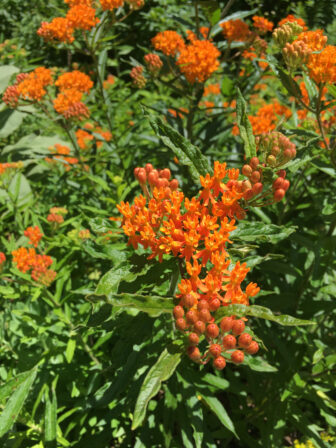This past week (June 21-27) was International Pollinator Week, a time to honor the work of the bees, butterflies, moths, flies, bats and beetles who intentionally or accidentally carry grains of pollen from male to female plant parts.
Without this service, 85 percent of the world’s flowering plants would be at the end of their line and our food supply would dwindle. 
Pollinators unfortunately earned their week by losing their habitat, being killed off by insecticides and facing stunning population declines. The insect Armageddon that has been in the headlines for years refers to studies indicating that overall, insects are in trouble.
Gardeners can play a supporting role for pollinators by cultivating host plants used by species to lay eggs and feed on. Eliminating or limiting the use of pesticides and herbicides is also vital to long-term insect health.
I started nurturing milkweed in my landscape a decade ago. Like many others, I was introduced to the relationship between pollinators and their plant partners through the plight of monarch butterflies. Monarchs are beloved and hold a special attachment for humans to the butterfly world. Their population has fallen 80 percent since the 1990s at their wintering sites in Mexico and 99 percent at locations in California.
In the eastern U.S., there are six species of milkweed that monarchs use to lay their eggs and for their larva to feed on. That’s it! Only six types of plants out of all the plants in the world. When I grew up, milkweed grew in our field and on roadsides. It was such a memorable plant with the white sap oozing out of the leaves. Now milkweed sightings are so uncommon, I take note whenever I see it.
The availability of milkweed is directly related to the monarch population. While the reasons for its disappearance are many, including the use of herbicides in agriculture and land development, the focus on exotic, ornamental plants for landscaping has contributed, too.
Asclepias tuberosa, or butterfly weed, is one of my favorite landscape plants. The orange blooms are a pop of color and it fits in nicely with any landscape aesthetic. Common milkweed (Asclepias syriaca) is the ubiquitous roadside plant. It’s a good fit for a wildflower landscape. What you’ll also discover, if you cultivate it, is its wonderful fragrance. It is blooming now in my yard and the lovely scent will greet me outdoors for weeks.
For wetter areas, swamp milkweed (Asclepias incarnate) will thrive with its bright pink blooms. The other species are harder to find in garden centers and include whorled milkweed, purple milkweed and poke milkweed. Research indicates that tropical milkweed (Aclepias curassivica), a plant that is not native to the U.S., can disrupt the monarch’s life cycle and should be avoided.
Here are other pollinator and plant relationships to consider supporting in your landscape.
If you want to see:
- The black swallowtail
Plant golden alexander (Zizia aurea). These are easy to grow and will multiply fast if you let them go to seed. They bloom early in the spring, making them an important nectar source, too. - The silvery checkerspot
Plant blackeyed susan (Rudbeckia hirta). This flower is common in nurseries and spreads out. To keep it contained, deadhead the flowers. - The viceroy
Plant black willow (Salix nigra). This willow likes wetter conditions and can be an effective sponge in marshy spots. - The red admiral
Plant false nettle (Boehmeria cylindrica). This plant lacks the stinging hairs of other nettles and appreciates part-shade and wetter soils. - The eastern swallowtail
Plant dill, fennel, parsley, rue or Queen Anne’s lace. All of these herbs are easy to grow from seed. Just plant a few extras to offer the larva. - The painted lady
Plant asters, ironweed (Vernonia fasciculate) and hollyhocks. Native asters bloom in the fall and also support pollinators as nectar sources after most plants are finished for the season.
There are many more relationships than I could share, but let this be a guide to getting started in landscaping with host plants.
Be aware that cultivars of a species might not have the same impact as the straight species. The Xerces Society, a nonprofit advocate for invertebrates, recommends avoiding cultivars. Research has shown that creating double blooms or changing the flower’s color makes the plant unviable as a host or nectar source. In other cases, not enough research has been done to understand the implications.
